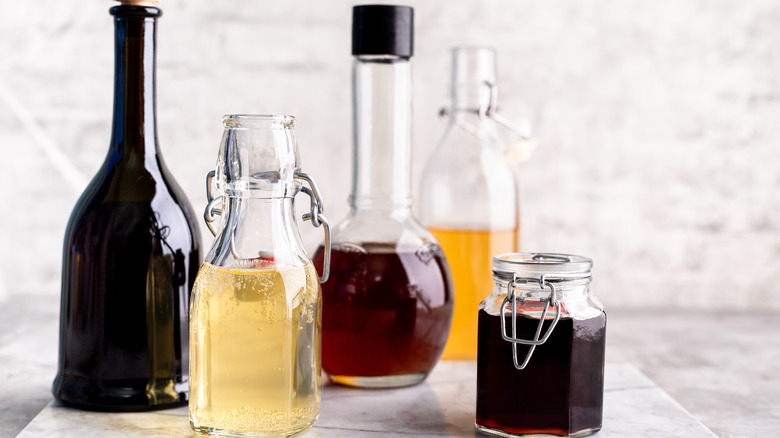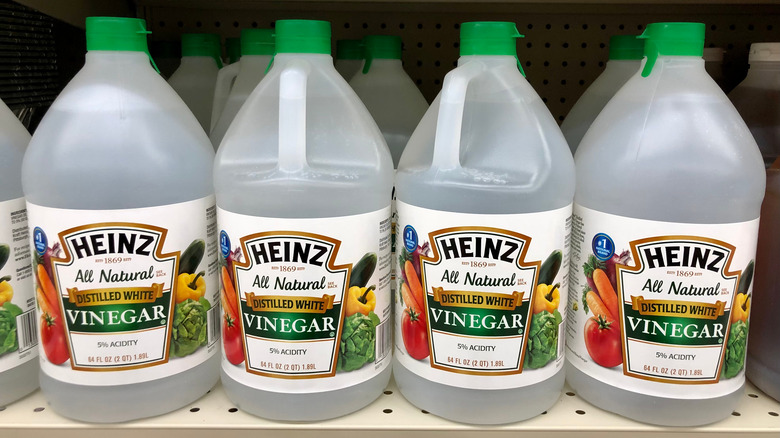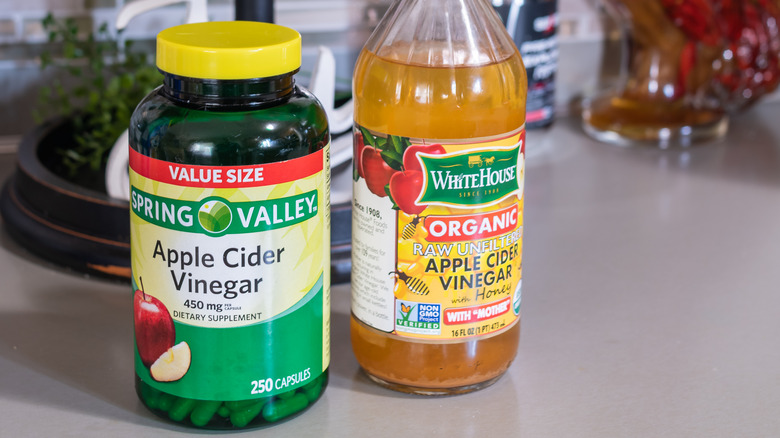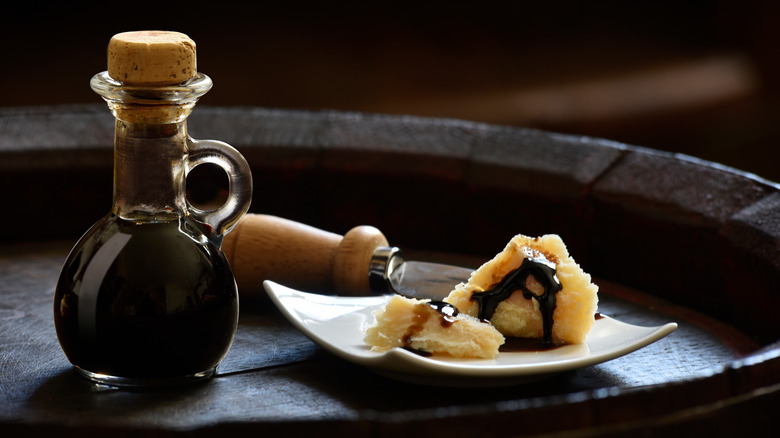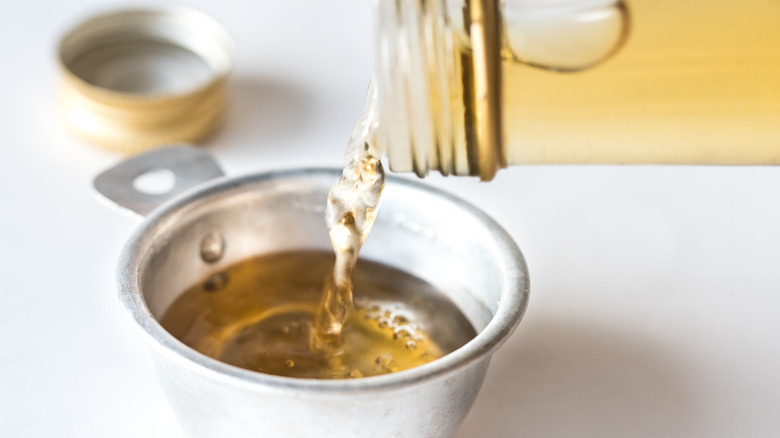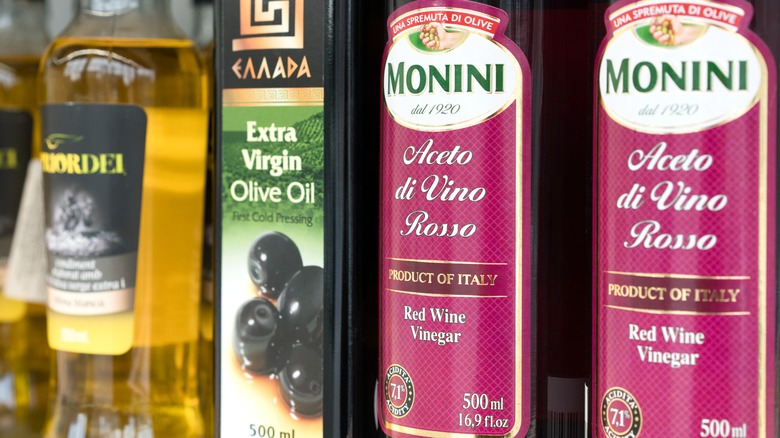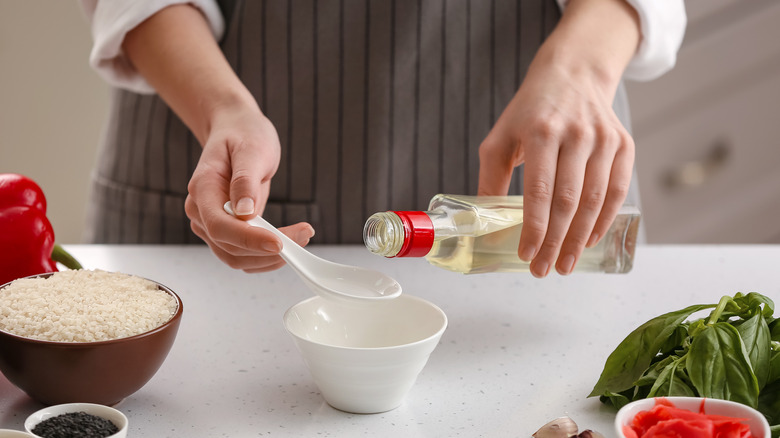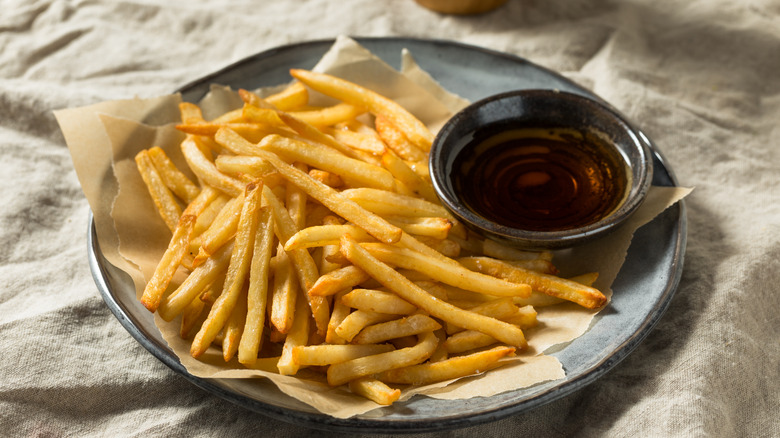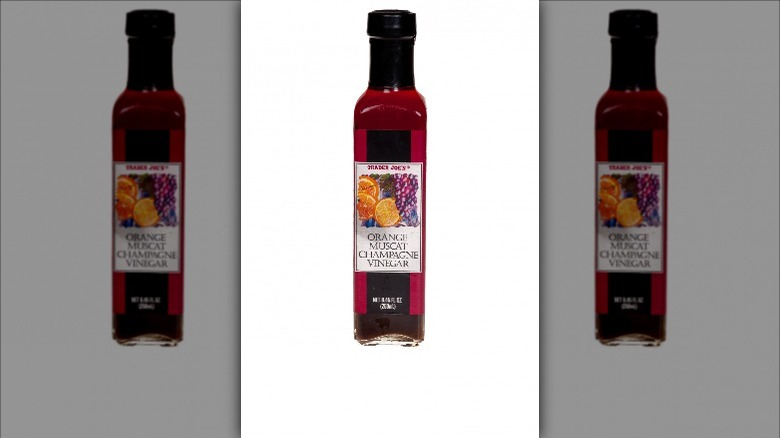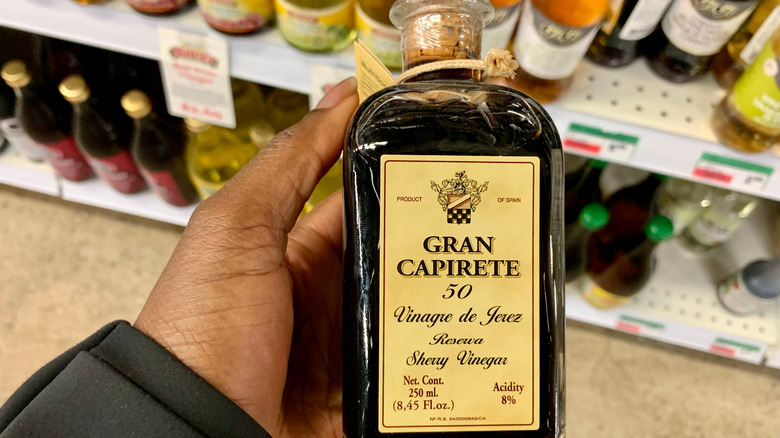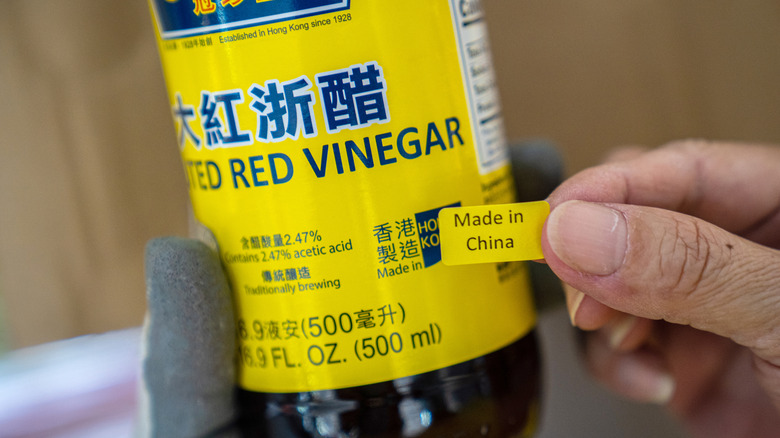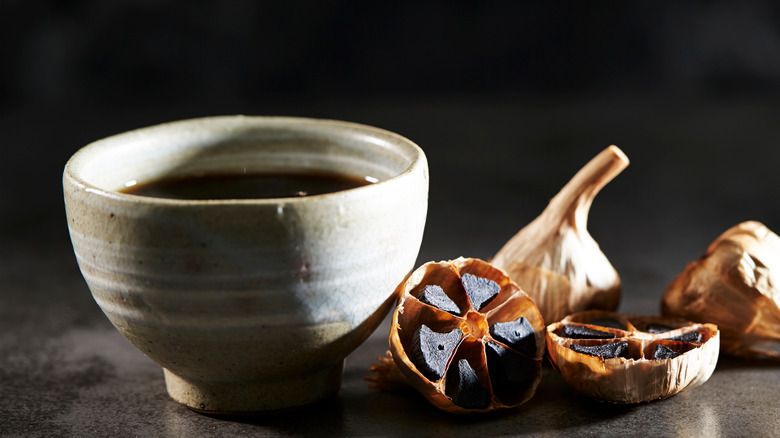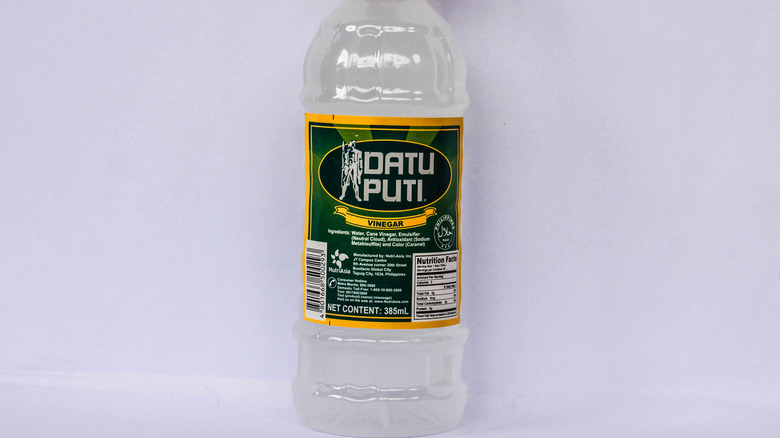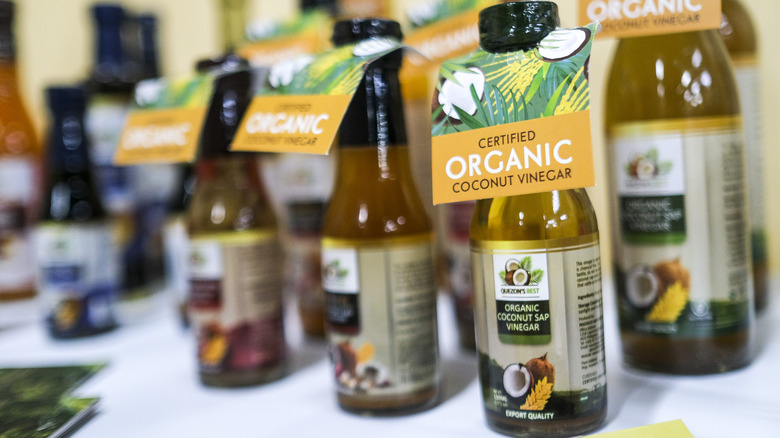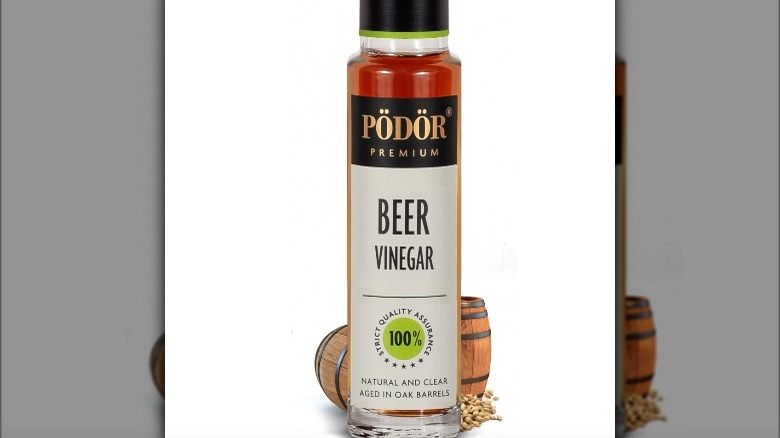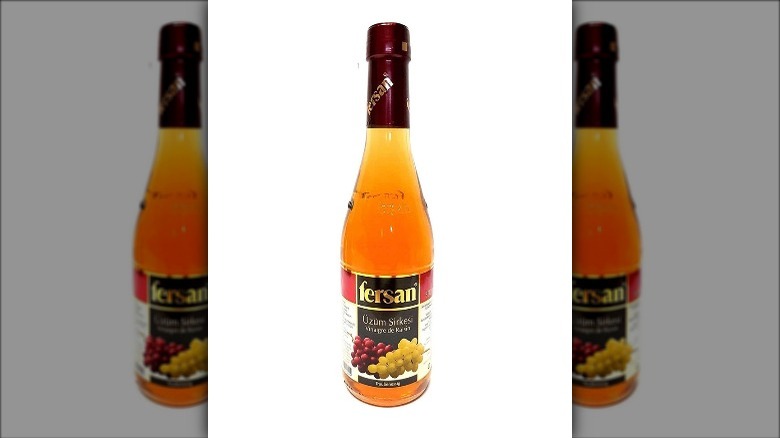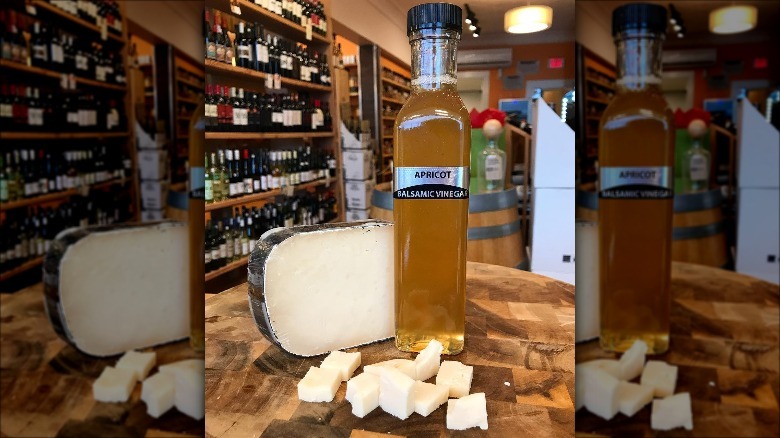16 Types Of Vinegar And When To Use Them
Most people are familiar with vinegar as a commonly used household staple. Yet, many of us are not aware of the specific properties of vinegar or the various kinds of vinegar and their myriad uses. Vinegar is an alcoholic liquid that attains its taste through a process of acetic fermentation. This process entails fermenting any kind of alcohol (wine, sherry, ethanol, etc.) with acetic acid. As a cooking ingredient, vinegar is a vital way of brightening up any dish by acting as a flavor enhancer such as salt.
This self-preserving liquid has been around since ancient times. The uses of vinegar extend far beyond pickles and salad dressings. Vinegar is also used for cleaning and personal care and has several other benefits. Since vinegar has so many different uses, it's important to know which kind suits your specific purpose. After all, you don't want to find yourself cleaning your clothes with red wine vinegar in an attempt to remove stains, only to find out that you're using the wrong kind of vinegar.
In order to maximize and attain the benefits of vinegar, understanding each type of vinegar and its specific characteristics is highly important. Once you have this information, it will help you think of new ways to utilize that bottle of vinegar at the back of the cupboard or inspire you to pick up a new type of vinegar from the grocery store.
Distilled white vinegar
Distilled white vinegar is a highly common and versatile kind of vinegar: It works for tons of recipes in the kitchen, but it might even be useful around the house. Distilled white vinegar can be mixed with baking soda, which produces a bubbling reaction that can help unclog drains (via Liquid Plumr).
It can be used to clean almost anything in your house as it kills bacteria and breaks down grease and dirt, thanks to the acetic acid, which is an ingredient found in many household cleaners (via Healthline). Distilled white vinegar provides an eco-friendly and low-cost way to clean floors, countertops, windows, tubs, and appliances. It's better for cleaning than other kinds of vinegar as it doesn't contain a coloring agent and is far less expensive to buy in bulk.
White distilled vinegar is distilled from ethanol and can also be used to eliminate odors and get rid of ants (via Go Forth). It's also a must-have for tougher home improvement projects, like getting rid of rust or removing marks from walls (via The Spruce). Additionally, according to The Gardening Cook, adding a little bit of white vinegar and sugar to a vase of cut flowers can help keep them fresh for longer. This vinegar is an extremely versatile ingredient that always gets the job done.
Apple cider vinegar
Apple cider vinegar has been having a moment in the holistic health and wellness space, and for a good reason too. This is essentially twice-fermented apple juice, but the tangy result is liquid gold with endless purposes.
In terms of health benefits, some studies suggest that apple cider vinegar may help lower blood sugar and aid in weight loss (via Cleveland Clinic). According to Bluefish Pediatrics, it's also a natural ingredient that helps get rid of warts on the skin, and many people use it in their general skincare regimes. As dermatologist Purvisha Patel tells Byrdie, apple cider vinegar is an astringent with antibacterial, anti-fungal, and antiviral properties that help balance the skin's pH levels and help prevent acne-related breakouts.
Apple cider vinegar is also a staple in the kitchen. It's an ideal mellow vinegar to use in pickling and preserving food (via Farmville Herald). Any vinegar containing at least 5% acetic acid is ideal for preserving foods, and apple cider vinegar falls into this category. It's also a key ingredient used in many marinades to enhance the flavors of meat (via Star Fine Foods).
Balsamic vinegar
Many people are familiar with balsamic vinegar. You may have dipped your before-dinner bread into some olive oil and balsamic vinegar sauce as a simple yet flavorful starter at a restaurant. Balsamic vinegar is also popularly used in salad dressing: Simply mix with honey, dijon mustard, and olive oil for the perfect drizzle (via Barefeet in the Kitchen). Additionally, this vinegar is low in calories and sugar, making it a great natural additive to add brightness to so many dishes.
If you are looking for a sweeter flavor, a balsamic glaze is perfect. While you can buy balsamic glaze premade at the grocery store, it's also fairly easy and quite satisfying to boil down the vinegar and sugar to create your own (via Allrecipes). Once this magic liquid is ready, you will find yourself drizzling it on anything and everything, from pizza to sandwiches to meat.
Considering its rich flavor profile, balsamic vinegar also makes for a unique addition to your cocktail: Difford's Guide has a recipe for a drink with vodka, strawberries, syrup, and balsamic vinegar that sounds like summer in a glass. Vinegar in cocktails might not be for everyone, but if you're someone who appreciates a complex drink with a savory element, it's a must-try.
White wine vinegar
White wine vinegar is a more refined version of distilled white vinegar: White wine vinegar is milder, and the flavor is a bit more complex like a good wine. This vinegar tends to go well with foods that you may pair with white wine, such as chicken, vegetables, fish, or any foods that are a bit on the lighter side.
White wine vinegar is typically more expensive than some other varieties of vinegar, such as distilled white or apple cider, but you can taste the difference. It's wonderful for creating an amazing brine for poultry or pork (via Food Network). It also always works well in salad dressing.
Taste of Home has a recipe for a white wine vinegar fruit salad dressing that is the ultimate way to amp up a plate of in-season summer fruit. Additionally, recipes for hollandaise sauce derive an additional kick through the addition of white wine vinegar.
Red wine vinegar
White wine vinegar has a red wine counterpart: Red wine vinegar is another mild yet robust vinegar that's a staple in many people's pantries. White wine vinegar may be the best choice for chicken and fish, but red wine vinegar is the only way to go for beef and pork dishes.
It helps tenderize the meat and brighten up its overall flavor if added to a simple marinade (via The Kitchn). Additionally, red wine vinegar can form the base for a delicious sauce that enhances the flavors of meat, as apparent in Food 52's chicken in red wine vinegar sauce recipe.
Some studies indicate that red wine vinegar may have health benefits like lowering blood sugar and preventing blood clots. Additionally, WebMD reports that red wine vinegar can also help support a nutritious diet. It is a staple ingredient in the Mediterranean diet that is considered to have numerous health benefits.
Rice vinegar
Rice vinegar, also known as rice wine vinegar, is a staple in Chinese, Vietnamese, Korean, and Japanese cuisines. It is made by fermenting rice. Plain rice vinegar has a very clean and acidic taste, as opposed to seasoned rice vinegar, which typically contains MSG or sugar. Seasoned rice vinegar is a staple in sushi rice. Sushi rice is made by adding a vinegar-based seasoning to rice (via Allrecipes). Though making sushi rice may sound straightforward and the overall recipe only uses a handful of ingredients, there is a specific technique to making this dish that requires time and patience.
Aside from sushi, rice vinegar can play a pivotal role in so many plates in the average home kitchen. It's a pivotal ingredient in a simple stir fry sauce, which typically includes ingredients like sugar, soy sauce, garlic, ginger, and more (via Simply Delicious Food). When used in a marinade, it can completely transform an ingredient like tofu and turn it into an incredible dish (via Nora Cooks). Additionally, rice vinegar is a great option for quick pickling vegetables like cucumbers, radishes, and carrots to add to dishes such as burgers, sandwiches, and salads (via Midwest Foodie Blog).
Malt vinegar
If you've never tried malt vinegar, you may have seen it in the condiment section. It is used in British cuisine and is often served in pubs alongside fries with salt, pepper, and ketchup. Malt vinegar is made by melting barley and typically has a brown color. It tends to have a nutty taste.
Malt vinegar is crucial to an authentic fish and chips experience and is a prime accompaniment to the dish. If malt vinegar appeals to you as a seasoning, you should check out Spicy Southern Kitchen's recipe for salt and vinegar potatoes: The malt vinegar is the star of the show in this dish.
Malt vinegar is similar to other kinds of vinegar in that it is a great way of enhancing several different recipes. It tends to add a distinct taste to a slow-cooked tomato chutney that, along with sugar, acts as a glue to the condiment (via Lovely Greens). Malt vinegar also makes for a great marinade, as apparent in the Framed Cooks recipe chicken recipe that utilizes a malt vinegar glaze containing molasses and honey.
In addition to cooking, malt vinegar can also be utilized as a natural household cleaner: The Wash recommends using it to remove limescale, particularly from a tea kettle: Simply mix the vinegar with water and boil to make an environmentally-friendly cleaning solution. Just ensure you rinse out the kettle after so that your tea isn't steeping in malt vinegar.
Champagne vinegar
Champagne Vinegar is made from Chardonnay and Pinot Noir grapes and usually has a higher price tag than most types of vinegar. However, it's more fruity and floral than your average wine-based vinegar.
This vinegar is commonly used in a champagne vinaigrette that is typically made using shallots, Dijon mustard, champagne vinegar, honey, and various seasonings (via Garlic and Zest). As Havasu Olive and Garlic Company's recipe with dill and peppercorns recommends, champagne vinegar is also great for making pickles.
If you're really looking to experiment with this acid, then Food & Wine has a recipe for pork braised in champagne vinegar that results in the kind of meat that falls apart on the fork and melts in your mouth. Some creative recipes also pair champagne vinegar with sweet dishes: Rosemary Mark's champagne vinegar and brown sugar syrup is simmered until thick and poured on top of berries and ice cream as a complex addition that elevates any average dessert.
Sherry vinegar
If champagne vinegar is light and mild, then sherry vinegar is nutty and rich. As you might have guessed, sherry vinegar is distilled from sherry wine that is native to Spain. It's a common ingredient in Spanish food and is used as a flavorful topping for cool summer gazpacho (via Washington Post).
Sherry vinegar is also often used in salad dressings and vinaigrettes, but it tends to give dishes a totally different profile than other, lighter types of vinegar. Since sherry vinegar is so bold, a vinaigrette made out of the acid holds up well when drizzled on dense root vegetables or hearty leafy greens (via Cooking Light).
When it comes to cooking, sherry vinegar is best utilized as part of a luscious pan sauce to accompany nearly any meat, particularly chicken. America's Test Kitchen has a recipe for a thyme-sherry vinegar pan sauce that enhances a basic roast chicken into something otherworldly.
Red rice vinegar
Many are familiar with rice vinegar but red rice vinegar may be an ingredient that is a little more unusual. Red rice vinegar is made from red yeast rice, which gets its color from a specific type of mold (via The Woks of Life). Red rice vinegar may not be as common as regular rice vinegar; it has a complex flavor that is as sweet as it is funky (via Masterclass).
If you have some red rice vinegar on hand, it can be added to a dumpling dipping sauce that contains the typical blend of ingredients such as soy sauce, rice vinegar, ginger, and sesame oil (via Big Oven). This vinegar can be incorporated into several different delicious recipes.
The Better Fish has a recipe for a roasted barramundi and vegetable dish smothered in tahini sauce. Red rice vinegar is the perfect addition to cut through that dense tahini, and it pairs perfectly with the fish and vegetables. The Spruce Eats also has a spicy Sichuan eggplant recipe featuring eggplant and ground pork cooked in a sauce that incorporates red rice vinegar.
Black vinegar
Black vinegar is one of the richest types of vinegar in terms of flavor. It's a staple in Chinese and Taiwanese cuisines. Black vinegar, also called black rice vinegar, is derived from grains: Brown rice, sorghum, wheat bran, and other grains are used in the process. It is aged in clay pots following the distillation process. Each pot has different notes; like a complex spirit or wine, no two bottles are alike.
Black vinegar has hints of licorice and malt along with a wonderful earthiness. A few drops of black vinegar are wonderful on a watermelon salad. Black vinegar is a key ingredient in many dishes, like the famous takeout hot and sour soup (via Washington Post). This soup attains its signature sour flavor from the addition of black vinegar.
It also has numerous health benefits (via Livestrong). It's full of amino acids that aid in countering lactic acid build-up in the blood stream and balancing the body's pH levels.
Cane vinegar
Cane vinegar may sound sweet, but it actually has a sour taste and forms an important element of Filipino cuisine. It is made with fermented molasses that are aged in jars sealed with banana leaves (via Epicurious). Cane vinegar is native to a region in North Philippines called Ilocos. It's acidic and bold on the tongue, similar to sherry vinegar.
It's a popular dipping sauce for everything from lumpia to slices of fruit, and it also tastes great cooked down into a glaze. It's also a necessary ingredient for making chicken adobo, as the dish basically consists of chicken braised in cane vinegar and soy (via Tasting Table).
While cane vinegar is commonly used in Filipino food, it is also useful in other dishes. Fine Cooking has a recipe for cane vinegar chicken stew with pearl onions, oranges, and spinach that is a total explosion of flavors in one dish, tied together by this magic ingredient. New York Times Cooking also features cane vinegar as part of the Haitian pork griot recipe, which is a delicious pork shoulder dish.
Coconut vinegar
Coconut vinegar is popularly used in Southern Indian and Southeast Asian cuisines. There are two types of coconut water: One is made by fermenting the sap from coconut flowers, the other is created by fermenting coconut water (via Bon Appetit).
It's hard to place the flavor of this vinegar, but it's more acidic than cane sugar vinegar. Coconut vinegar doesn't taste like the quintessential coconut flavor whatsoever; rather, it is similar to apple cider vinegar but tends to have a sweeter and less acidic taste.
Coconut vinegar is used in a Filipino ceviche called kinilaw as well as to make a spicy condiment to amp up other dishes. Additionally, coconut vinegar can also be used in marinades, pickles, and curries (via Epicurious). Food & Wine has a recipe for a spicy coconut vinegar braised pork that's as tender as it gets.
Coconut vinegar has been receiving some buzz in the health space, even though it's been a part of various cuisines for centuries. Coconut vinegar is filled with vitamins, minerals, and amino acids, as well as probiotics that support healthy digestion (via Daily Burn). Dr. Oz also recommends using coconut vinegar in a mocktail as a substitute for booze which is ideal for those looking for an alcohol-free drink.
Beer vinegar
Considering the fact that all vinegar is essentially fermented booze, the existence of beer vinegar actually makes a lot of sense. Beer vinegar is similar to malt vinegar, and can be made from any type of beer (via Honest Food). It's quite simple to make at home: Simply combine any beer with vinegar mother, cover with a towel, and let it sit in a warm, dark place for one to two months.
Renowned chef Jonathan Sawyer shares his signature beer vinegar recipe with Taste Cooking and recommends using a beer with minimal hops and letting the mixture rest for two weeks. You can test the vinegar with pH strips or based on taste: Either way, the results are quite tasty.
Beer vinegar can be incorporated in simple home cooking as well as fine dining: The Kitchn recommends using beer vinegar for rib marinade or a vinaigrette for taco salad.
Simple sautéed chanterelle mushrooms and radishes can be amped up in flavor via a dose of beer vinegar (via Honest Cooking).
Oyster mignonette, which typically includes red wine vinegar and shallots, can get a real makeover by replacing the red wine vinegar with beer vinegar (via Oyster Obsession). On the more complex end of recipes, Great British Chef's recipe for a chicken wing with cured duck liver and beer vinegar may be the most delicious way to eat a wing ever.
Raisin vinegar
Raisin vinegar is made by combining raisins with liquid (usually alcohol or water) and letting it ferment (via Steemit). Raisin vinegar has a smooth, complex flavor and tends to age very well (via Pro Home Cooks). It generally takes about 30 days to ferment. If you aren't into DIY, some people do sell bottles of raisin vinegar online (via Etsy). Some at-home fermenters have experimented with inventive concoctions such as cranberry raisin vinegar.
Raisin vinegar is mostly produced in Turkey, and it's also popularly used in Middle Eastern and Greek cuisines (via Cook's Info). Raisin vinegar is also called khal 'anab in Arabic. It has a brown coloring and can be added to salad dressings and sautéed with vegetables for an acidic kick (via Web Restaurant Store). It can also be used to make agrodolce sauce which entails sautéing onion, lemon zest, pepper flakes, and vinegar-soaked raisins in a pan and garnishing with parsley.
Apricot vinegar
Any fruit can be used to make vinegar, including ripe and juicy apricots. Unlike coconut vinegar, this type of vinegar actually tastes distinctly like the fruit in its name. Apricot vinegar is tangy and bright and pairs wonderfully well with several different dishes. Pödör sells an apricot vinegar that is fermented in oak barrels and provides an easy way to purchase this vinegar and start using it as an ingredient in cooking.
Apricot vinegar forms a great base for an apricot glaze that's ideal for chicken (via The Olive Tap Recipes). The result is a chicken dish that's bursting with flavor and has a similar flavor profile to a balsamic vinegar base. Additionally, apricot vinegar can be used to spice up your typical salad dressing. Key Ingredient has a one-of-a-kind recipe that's a must-try for more adventurous eaters: It uses an apricot vinegar, fig vinegar, and olive oil vinaigrette drizzled over romaine lettuce, sweet peppers, olives, and dried figs.
